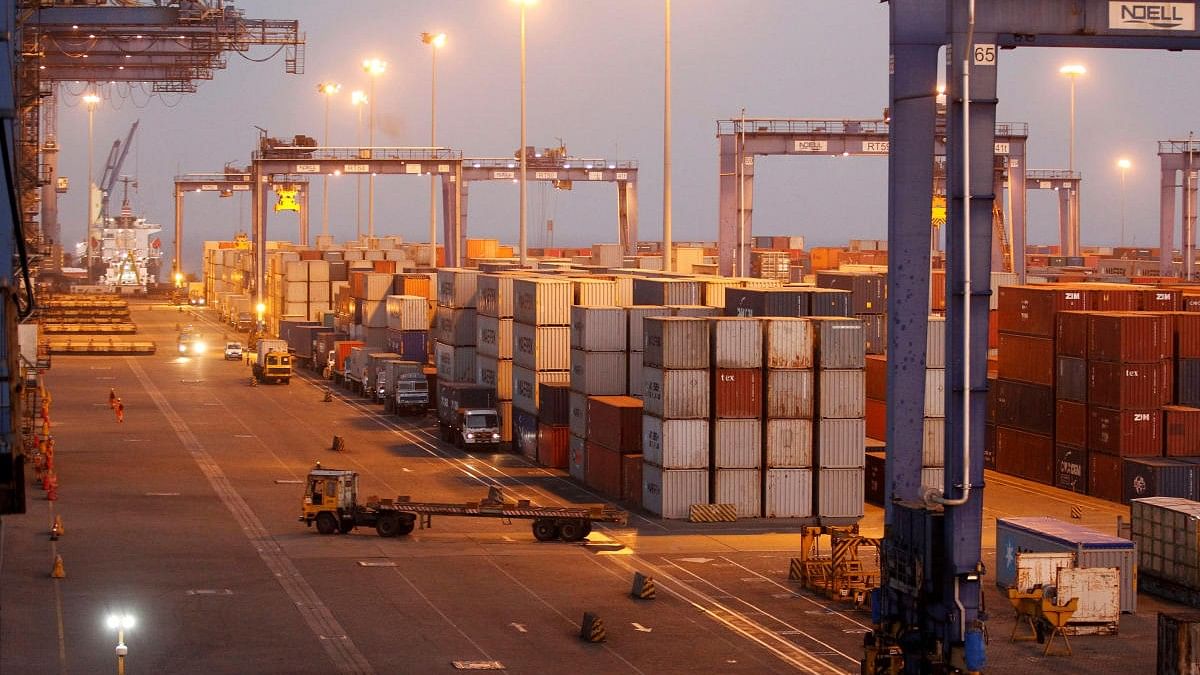
A general view of a container terminal seen at Mundra Port in Gujarat,
Credit: Reuters Photo
In FY2023, India's merchandise exports reached $451 billion as against $421 billion in FY2022. Coincidentally, both the products and the states contributing to it remained similar. The states which contributed to the major share of these were: Gujarat (33 per cent), Maharashtra (16 per cent), Tamil Nadu (9 per cent), Karnataka (6 per cent), and Uttar Pradesh (5 per cent).
A deeper analysis of the districts showed that just 10 districts constituting less than 1.5 per cent of the 766 districts across India are contributing to 41 per cent of the country’s exports. These include, in ascending order of contribution: Jamnagar, Surat, Mumbai, Mumbai Suburban, Kanchipuram, Pune, Bharuch, Gautam Budh Nagar, Ahmedabad, and Kachchh. This extremely high concentration of exporting districts is something to ponder about.
Policymakers need to focus on the ‘missing middle-export districts’. An analysis of the districts which have exports between $1 billion to $5 billion, shows that there are 59 districts or ‘missing middle-export districts’ which have the potential to ease the current high concentration in just 10 districts. This also amplifies the significant potential that exists to garner higher exports.
These 59 districts are spread across 20 states and union territories, and currently constitute 29 per cent of India’s exports in FY2023.
Such diversification will also bring in a holistic export growth paradigm while also helping various other districts in India to grow and develop.
Recently, India introduced the ODOP-DEH (One District One Product-Districts as Export Hubs), which was also mentioned in the new foreign trade policy. The initiative aims at fostering balanced regional development across the identified 734 districts under it, while promoting one product from each district. The objective is to work with manufacturers and producers across districts along verticals like design, production, manufacturing, packaging, and market creation to boost sales both in the domestic as well as international markets.
What the government could do is roll out the ODOP-DEH across the 734 districts at a later stage after it has focused on the 59 ‘missing middle-export districts’, thereby reducing the current anomaly at the district level for exports.
In most cases, there is a significant synergy between the products identified under ODOP-DEH, though there also exists some divergences. For instance, the key exports worth $1.6 billion from Sonipat in Haryana include leather products, footwear, engineering goods, and plastic products. However, the ODOP-DEH mentions the focus to be on ‘industries’, without specification which one. This is contrary to the ODOP-DEH, which envisages capitalising on a unique product from each district, with the goal to uplift the local community, and create a multiplier effect on the local economy.
Another such example is Karnataka's Kolar district where the major export today is smartphones — which form about 89 per cent of its total exports. Under the ODOP-DEH initiative, Kolar has been identified with a diverse range of products, from mango, colour capsicums, millet ragi, mango pulp, processed pulses, spices, engineering, aerospace and defence components, automobiles, phones, apparel to many others. Concentrated attention may be the way forward here.
The crux towards having a successful ODOP-DEH would be when new export districts beyond the perennial ones are provided an opportunity in terms of new companies and greater capex being set up.
The ODOP-DEH can also learn from similar initiatives abroad. For instance, Japan's ‘One Village, One Product’ (OVOP) initiative underscores the importance of community involvement and the preservation of cultural heritage. Thailand's experience highlights the significance of sustainable growth and the incorporation of modern techniques while staying true to traditional skills. Mexico, the Philippines, and Ghana offer insights into creating an environment where local products become a source of pride and economic empowerment.
The ODOP-DEH’s possible focus on the identified 59 ‘missing middle-export districts’ in all probability will help to reduce the existing export concentration, while also augmenting India’s overall export share globally, which has been hovering around 2 per cent for a long time. Such efforts will build upon India’s ambition to have $1 trillion in merchandise exports by 2030.
A focus on these ‘missing middle-export districts’ would be a good step towards transforming India's diverse districts into thriving centres of excellence on the global stage. By further developing newer districts, India will be able to create more export hubs which would usher in a new growth story.
(Rahul Mazumdar is an economist with India Exim Bank. Views expressed are personal. X: @RahulMazumdar)
Disclaimer: The views expressed above are the author's own. They do not necessarily reflect the views of DH.